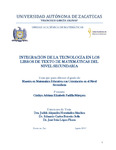
Please use this identifier to cite or link to this item:
http://ricaxcan.uaz.edu.mx/jspui/handle/20.500.11845/1230Full metadata record
| DC Field | Value | Language |
|---|---|---|
| dc.contributor | 863466 | es_ES |
| dc.contributor.advisor | Judith Alejandra Hernández Sánchez | es_ES |
| dc.contributor.author | Eduardo Carlos Briceño Solís | es_ES |
| dc.contributor.author | José Iván López Flores | es_ES |
| dc.coverage.spatial | Zacatecas, México | es_ES |
| dc.creator | Padilla Marquez, Cinthya Adriana Elizabeth | - |
| dc.date.accessioned | 2019-10-23T15:38:24Z | - |
| dc.date.available | 2019-10-23T15:38:24Z | - |
| dc.date.issued | 2019-06-27 | - |
| dc.identifier | info:eu-repo/semantics/publishedVersion | es_ES |
| dc.identifier.uri | http://ricaxcan.uaz.edu.mx/jspui/handle/20.500.11845/1230 | - |
| dc.description | In the last 10 years, the Ministry of Public Education has proposed changes to the plans and study programs of the Secondary Level where technology is presented as an important element. The previous, given the advantages that can produce in the learning of the students, like: helping to better understand what can hardly be understood with the traditional method; supports learning and strengthening mathematics, expands cognitive abilities and student performance. However, the literature shows that the integration of technology in the mathematics classroom has not been achieved. This is due to the fact that there are variables of different kinds that can affect; Some are those of an institutional nature, linked to the decisions of the authorities. In this area are the textbooks that are endorsed by the education authorities. Since they are the main tool of work of teachers and students, conditioning in most cases the teacher's speech. Therefore, this paper describes how technology is introduced in the textbooks of mathematics of the Secondary Level in Mexico. To achieve this, a conceptual framework focused on what Technology, Integration and Textbooks are meant to be built. In addition, other notions such as uses, intentions and levels of technology integration were taken up from other research. This allowed us to describe how textbooks propose using technology in the teaching and learning of mathematics. The methodology is mixed, with a descriptive and interpretative scope applying the content analysis method. Among the results that were found, it was observed that the didactic dimensions are more frequently promoted in the editorial Santillana and Patria textbooks, in counterpart the least presence is the computer dimension. | es_ES |
| dc.description.abstract | En los últimos 10 años, la Secretaría de Educación Pública ha propuesto cambios a los planes y programas de estudio del Nivel Secundaria donde la tecnología se presenta como un elemento importante. Lo anterior, dadas las ventajas que puede producir en el aprendizaje de los estudiantes, como: ayudar a comprender mejor lo que difícilmente se puede comprender con el método tradicional; apoyar a aprender matemáticas y fortalecerlas, amplíar las capacidades cognitivas y el desempeño de los estudiantes. Sin embargo, la literatura evidencia que no se ha logrado la integración de la tecnología en las aulas de matemáticas. Esto se debe a que existen variables de diferente índole que pueden incidir, unas son las de corte institucional, ligadas a las decisiones de las autoridades. En este rubro se encuentran los libros de texto que son avalados por las autoridades educativas; puesto que se constituyen en la principal herramienta de trabajo de los profesores y estudiantes, condicionando en la mayoría de los casos el discurso del profesor. Por lo tanto, en este trabajo se describe cómo se introduce la tecnología en los libros de texto de matemáticas del Nivel Secundaria en México. Para lograrlo se construyó un marco conceptual centrado en lo que significa Tecnología, Integración y Libros de Texto. Además, se retomó de otras investigaciones nociones como los usos, intencionalidades y niveles de integración de la tecnología. La metodología es de corte mixto, con un alcance descriptivo e interpretativo aplicando el método del análisis de contenido. Entre los resultados que se encontraron se observó que la dimensión didáctica se potencia con mayor frecuencia en los libros de texto de la editorial Santillana y Patria; en contraparte la de menor presencia es la dimensión informática. | es_ES |
| dc.language.iso | spa | es_ES |
| dc.publisher | Universidad Autónoma de Zacatecas | es_ES |
| dc.relation.isbasedon | Maestría en Matemática Educativa con Orientación en el Nivel Secundaria | es_ES |
| dc.relation.uri | generalPublic | es_ES |
| dc.rights | Atribución-NoComercial-CompartirIgual 3.0 Estados Unidos de América | * |
| dc.rights.uri | http://creativecommons.org/licenses/by-nc-sa/3.0/us/ | * |
| dc.subject.classification | HUMANIDADES Y CIENCIAS DE LA CONDUCTA [4] | es_ES |
| dc.subject.other | Tecnología | es_ES |
| dc.subject.other | Libros de texto | es_ES |
| dc.subject.other | Integración | es_ES |
| dc.subject.other | Niveles | es_ES |
| dc.subject.other | Usos | es_ES |
| dc.title | Integración de la tecnología en los libros de texto de matemáticas del nivel secundaria | es_ES |
| dc.type | info:eu-repo/semantics/masterThesis | es_ES |
| Appears in Collections: | *Tesis*-- UA Matemáticas | |
Files in This Item:
| File | Description | Size | Format | |
|---|---|---|---|---|
| 2019 Padilla, C.A.E..pdf | Tesis de Padilla 2019 | 2,44 MB | Adobe PDF |  View/Open |
This item is licensed under a Creative Commons License
